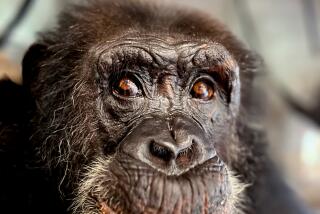Jane Goodall, conservationists hope ‘Chimpanzee’ will save chimps
- Share via
Jane Goodall was clearly out of her element recently when she walked the red carpet for the premiere of a new film. After all, the conservationist has spent much of the last 50 years in the wilds of Africa studying primates.
But this was no mere movie, and the title alone explains why it brought Goodall, 78, to a red carpet in Orlando, Fla. Disneynature’s “Chimpanzee” opens in theaters Friday, giving the world a breathtaking glimpse into the lives of a family of chimps in the Tai Forest National Park in Africa’s Ivory Coast.
Goodall had no role in the making of the film, which took four years. But she and other conservationists are hoping it will help erase the notion of chimps as cheeky little pets or circus performers, and fuel conservation efforts to save the endangered primates from poaching and encroachment.
“The film will help the chimpanzees’ exposure,” Goodall said at the premiere. “People will know more, and hopefully will contribute more to The Jane Goodall Institute.”
Does that sound like a little self-promotion? It is. But if anyone is allowed a little self-promotion, conservationists say, it’s Goodall.
Goodall is considered one of the “founding mothers” of Great Ape conservation. “She is really the primary reason people know what they know today about chimps,” said Matthew Lewis of the World Wildlife Fund.
Lewis is the senior program officer for African Species Conservation at the WWF. He told the Times that the new movie -- which is narrated by Tim Allen and tells the story of a young chimp named Oscar -- comes at a crucial moment for the primates.
About 50 years ago, there were more than a million chimpanzees in the wild in Central and West Africa, he said. Today, there are about 300,000, and their numbers continue to dwindle. The causes are varied, but they include forest-clearing, which destroys the chimps’ habitat; poachers, who feed the “bush meat” market; and the deadly Ebola virus, which can rip through and kill as many as 90% of a clan’s population, he said.
And then there is the disturbing pet trade.
Chimps are fiercely protective of their young, so hunters usually kill off the parents in order to seize baby chimps for exotic collectors, he said.
“It’s still a pretty bleak scenario right now for chimps,” Lewis said.
He hopes that this new movie will allow viewers to see chimps in a new light -- not as movie performers, or as pets to be put in cages, but as sensitive creatures that share the bulk of their DNA with humans.
“Chimps running around in diapers, or doing tricks -- that’s the image that many people have of chimps,” he said.
“I hope this movie drives home the point that the future for chimps is conservation in the wild, not in captivity. Chimps in captivity never end well,” Lewis said. He was referring to the headline-making case of a chimp living as a pet in Connecticut who mauled a woman in 2009, ripping off her thumbs and her face. The victim ultimately required a face transplant and continues to recover. The chimp was shot and killed by police.
“This is a movie that will show people chimps in the wild being chimps,” he said. “It will show people how complex, unique and special they are.”
Lewis said that people can support chimpanzee conservation by discouraging their use as pets and in medical experiments, and by being discerning customers. He suggested that when purchasing wood products from Central and West Africa, consumers should look for the stamp of approval from the Forest Stewardship Council, which is dedicated to responsible forest management.
ALSO:
‘Killer’ swan attacks Illinois caretaker until he drowns
Kate Winslet: ‘Titanic’ theme song makes me want to throw up
Ashley Judd rips media, public for ‘nasty’ attack on body image
Join Rene Lynch on Google+, Facebook or Twitter
More to Read
Sign up for Essential California
The most important California stories and recommendations in your inbox every morning.
You may occasionally receive promotional content from the Los Angeles Times.











